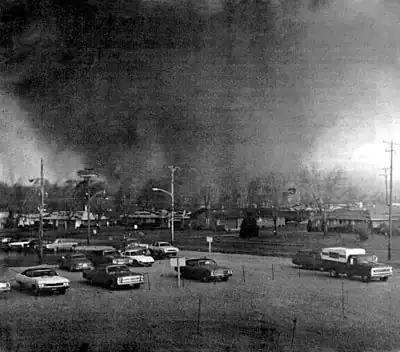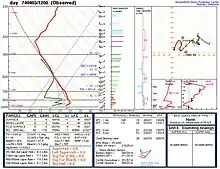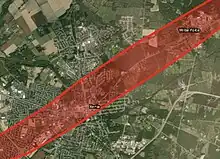1974 Xenia tornado
On April 3, 1974, a tornado struck Xenia and Wilberforce, Ohio, killing 36 people. It is the deadliest individual tornado of the 1974 Super Outbreak. The tornado destroyed a large portion of Xenia, which caused meteorologist Dr. Ted Fujita to initially assign a preliminary rating of F6 intensity of ± 1 on the Fujita scale, making it the second tornado to receive this rating, the first being the 1970 Lubbock tornado. However, the rating was later downgraded to F5 after Fujita deemed F6 ratings "inconceivable".[2]
 The tornado tearing through the southeast Pinecrest Garden district. | |
| Meteorological history | |
|---|---|
| Duration | 39 minutes |
| Formed | April 3, 1974, 4:33 p.m. EDT (UTC–04:00) |
| Dissipated | April 3, 1974, 5:12 p.m. EDT (UTC–04:00) |
| F5 tornado | |
| on the Fujita scale | |
| Highest winds | 250 to 305 mph (402 to 491 km/h) |
| Overall effects | |
| Fatalities | 36 |
| Injuries | 1,150 |
| Damage | $100 million (1974 USD) ($593 million in 2022) |
| Areas affected | Xenia and town of Wilberforce, Ohio |
| [1] | |
Part of the 1974 Super Outbreak and Tornadoes of 1974 | |
Meteorological synopsis

A powerful springtime low pressure system developed across the North American Interior Plains on April 1. While moving into the Mississippi and Ohio Valley areas, a surge of moist air intensified the storm. There were sharp temperature contrasts between both sides of the system. Officials at NOAA and in the National Weather Service forecast offices were expecting a severe weather outbreak on April 3, but not to the extent that ultimately occurred. Several F2 and F3 tornadoes had struck portions of the Ohio Valley and the South in a separate, earlier outbreak—occurring on April 1 and 2—which included three deadly tornadoes in Kentucky, Alabama, and Tennessee. The town of Campbellsburg, Kentucky, northeast of Louisville, had large portions destroyed by an F3 tornado after an earlier outbreak.[3] Between the two outbreaks, an additional tornado was reported in Indiana on the morning of April 3, several hours before the official start of the outbreak.[4] On April 3, severe weather watches were issued south of the Great Lakes, while in portions of the Upper Midwest, snow was reported, with heavy rain falling across central Michigan and most of Ontario.
Tornado summary
The tornado formed near Bellbrook, Ohio, southwest of Xenia, at about 4:30 pm EDT. It began as a moderate-sized tornado, later intensifying after moving northeast at about 50 mph (80 km/h). The tornado exhibited a multiple-vortex structure, which was described as a "pair of funnels coming together",[5] and became very large as it approached town. Gil Whitney, the weather specialist for WHIO-TV in Dayton, alerted viewers in Montgomery and Greene Counties (where Xenia is located) about the possible tornado, broadcasting the radar image of the supercell with a pronounced hook echo on the rear flank of the storm several minutes before it struck. The storm was visible on radar because of raindrops wrapping around the circulation.[6] The massive tornado went into the western part of Xenia, completely flattening the Windsor Park and Arrowhead subdivisions at an intensity of F5 and sweeping away entire rows of brick homes with little debris left behind. Extensive wind-rowing of debris occurred in nearby fields.[7]

When the storm reached central Xenia at 4:40 pm, apartment buildings, homes, businesses, churches, and schools—including Xenia High School—were destroyed. At this time, the tornado was videotaped and was observed to have "as many as five subvortices merging into one" tornado.[5] Students in the school, practicing for a play, took cover in the main hallway seconds before the tornado dropped a school bus onto the stage where they had been practicing and extensively damaged the school building.[4][8] Several railroad cars were lifted and blown over as the tornado passed over a moving Penn Central freight train in the center of town.[9] It toppled headstones in Cherry Grove Cemetery, then moved through the downtown business district, passing west of the courthouse, which sustained some exterior damage. Numerous businesses in downtown Xenia were heavily damaged or destroyed, and several people were killed at the A&W Root Beer stand as the building was flattened. At the time, this was the state's highest tornadic death toll for a single building since 1953.[10] Past downtown, the tornado continued into the Pinecrest Garden district.

The Xenia tornado was recorded on film by one resident, and its sound was recorded on tape by a Mr. Brokeshoulder from inside an apartment complex. Before the tornado hit the building, the resident left the tape recorder on, and it was found after the storm. At the same time, a few blocks away, 3 minutes and 21 seconds of footage were captured by 16-year-old Xenia resident Bruce Boyd with a "Super-8" 8mm movie camera, a pre-1973 model without sound recording capability. The footage was later paired with the nearby tape recording. Boyd's film[11] shows multiple vortices within the larger circulation as the storm swept through Xenia. Upon exiting, the tornado passed through Wilberforce, heavily damaging several campus and residential buildings of Wilberforce University.[9] Central State University sustained considerable damage, and a water tower was toppled. Afterwards, the tornado weakened before dissipating in Clark County near South Vienna, traveling approximately 30 miles (48 km). Its maximum width was a half-mile (0.8 km) in Xenia. The same parent storm spawned a weaker tornado northeast of Columbus in Franklin County.[4]
A total of 32 people lost their lives in the tornado, and about 1,150 were injured in Xenia, several of whom took proper shelter.[12][13] In addition to fatalities, two Ohio Air National Guardsmen deployed for disaster assistance were killed on April 17 when a fire swept through their temporary barracks in a furniture store. The memorial in downtown Xenia lists 34 deaths in honor of the two Guardsmen.[14][15][10] About 1,400 buildings, roughly half of the town, were damaged or destroyed. Damage was estimated at US$100 million ($593 million in 2022).
Aftermath

President Richard Nixon made an unannounced visit to Xenia a few days later. It would be the first and only city affected by the 1974 Super Outbreak that he would visit. Upon inspecting the damage, he said: "As I look back over the disasters, I saw the earthquake in Anchorage in 1964; I saw the hurricanes... Hurricane Camille in 1969 down in Mississippi, and I saw Hurricane Agnes in Wilkes-Barre, Pennsylvania. And it is hard to tell the difference among them all, but I would say in terms of destruction, just total devastation, this is the worst I have seen."[16] President Nixon immediately declared Xenia a disaster area. Although the Federal Disaster Relief Act was already introduced in 1973, it had not passed Congress at the time. The 1974 Super Outbreak disaster was a catalyst for accelerated passage of the act through Congress in 1974, according to Nixon.[17] It took several months for the city to recover from the tornado, with the help of the Red Cross and the Ohio National Guard assisting the recovery efforts.[18] In recognition of their coverage of the tornado under difficult circumstances, the staff of the Xenia Daily Gazette won the Pulitzer Prize for Spot News Reporting in 1975.[19] The Xenia tornado was one of two rated F5 tornadoes that affected Ohio during the outbreak, the other striking the area of Cincinnati. Xenia was later struck by two other tornadoes—a small one in April 1989 and a large one in September 2000, which was an F4 tornado that killed one and injured about 100 in an area parallel to and north of the 1974 path.[20] Before the 1974 storm, the city had no tornado sirens. After the F5 tornado hit on April 3, 1974, ten sirens were installed across the area.[21]
Preliminary F6 rating
Dr. Ted Fujita and a team of colleagues from the University of Chicago, University of Oklahoma, and National Severe Storms Laboratory, undertook a 10-month study of the 1974 Super Outbreak. Along with discovering new knowledge about tornadoes, such as downbursts and microbursts, and assessing damage to surrounding structures, the Xenia tornado was determined to be the worst out of 148 storms.[22][23] Fujita initially assigned a preliminary rating of F6 intensity ± 1 scale,[24] before stating F6 ratings were "inconceivable".[2]
See also
References
- T. Theodore Fujita (21–23 October 1975). "NEW EVIDENCE FROM APRIL 3-4, 1974 TORNADOES" (PDF). Ninth Conference on Severe Local Storms. The University of Chicago: 1–9. Retrieved 5 August 2023.
- Flowers, Andy (8 December 2011). "How will you handle winds of change if they approach F6?". Hill Air Force Base. Archived from the original on 20 September 2023. Retrieved 20 September 2023.
- NWS Louisville. "April 1, 1974". Crh.noaa.gov. Retrieved 2007-03-03.
- Grazulis, Thomas P. (July 1993). Significant Tornadoes 1680–1991. St. Johnsbury, VT: The Tornado Project of Environmental Films. ISBN 978-1-879362-03-1.
- "48th anniversary of devastating Xenia tornado". WCMH-TV. NBC News. 4 April 2022. Retrieved 18 February 2023.
- Simpson, Jamie (March 31, 2004). "Radar Provides Life-Saving Warnings Of Tornadoes". WHIO-TV (Dayton, Ohio). Archived from the original on February 11, 2008.
- "Aerial Damage Photographs". NWS Wilmington, OH. NOAA. April 1, 2013. Retrieved August 31, 2014.
- Rosenfield, Jeffrey (2003). Eye of The Storm: Inside the World's Deadliest Tornadoes, Hurricanes, and Blizzards. Basic Books. p. 320. ISBN 978-0738208916.
- Ohio Historical Society. "April 3, 1974: Xenia Tornado". Ohiohistory.org. Archived from the original on September 27, 2013. Retrieved 2015-10-26.
- Schmidlin, Thomas W.; Schmidlin, Jeanne Appelhans (9 August 1996). Thunder in the Heartland: A Chronicle of Outstanding Weather Events in Ohio. Kent State University Press. pp. 283–288. ISBN 9780873385497. Retrieved 14 March 2019 – via Google Books.
- Boyd, Bruce (April 3, 2011). "Xenia Ohio Tornado". YouTube.
- T. Theodore Fujita. "STATISTICS OF APRIL 3-4, 1974 TORNADOES" (PDF). University of Chicago.
- Bigler, Virginia J. (1975). "The Xenia Tornado—At Its Beginning". Weatherwise. 28 (2): 78–79. doi:10.1080/00431672.1975.9931741. Retrieved 18 February 2023.
- "The Indefinitive List of the Strongest Tornadoes Ever Recorded (Part IV) |". Extremeplanet.me. November 27, 2012. Archived from the original on April 7, 2019. Retrieved April 18, 2013.
- "April 3, 1974 Xenia Tornado Memorial Marker". Hmdb.org. Retrieved April 18, 2013.
- Woolley, John T.; Peters, Gerhard (via Richard Nixon) (April 13, 1974). "Remarks During an Inspection Tour of Tornado Damage in Ohio". The American Presidency Project. Retrieved April 25, 2011.
- Nixon, Richard M. (1974). "The President's Remarks at the Bill Signing Ceremony at the White House. May 22, 1974" (PDF). Presidential Documents: Richard Nixon, 1974. 10 (21): 788. Archived from the original (PDF) on November 24, 2011. Retrieved 2011-04-26.
- "30th Anniversary of the 1974 Xenia Tornado". Omp.ohiolink.edu. Archived from the original on 2009-10-11. Retrieved 2015-10-26.
- "1975 Winners". Pulitzer.org. Retrieved June 12, 2012.
- Sharp, Debra (April 2, 1999). "Super tornado outbreak : Xenia, Ohio, serves as twister memorial". USA Today.
- Taylor, David (September 22, 2000). "Few warned of twister". The Cincinnati Enquirer.
- "Tetsuya Theodore Fujita". The Tornado Project. 1998. Archived from the original on November 30, 2010. Retrieved 2011-04-26.
- "Analysis and Reconstruction of the 1974 Tornado Super Outbreak" (PDF). Risk Management Solutions. April 2, 2004. p. 5. Archived from the original (PDF) on July 10, 2007. Retrieved 2011-04-26.
- Fujita, T. Theodore (1974). "Jumbo Tornado Outbreak of 3 April 1974" (PDF).